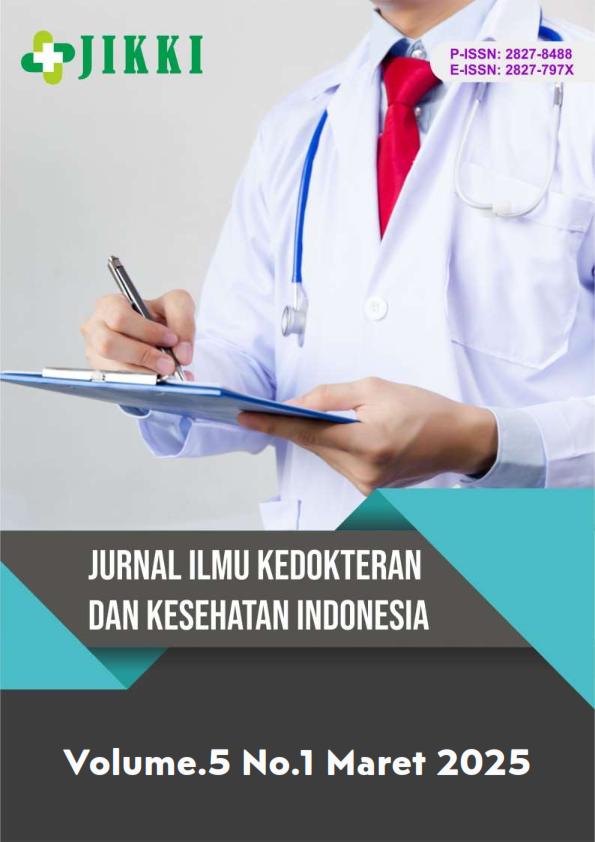Lipid Panel Predictors of Urinary Incontinence in Elderly in Bina Bakti Nursing
DOI:
https://doi.org/10.55606/jikki.v5i1.6055Keywords:
Elderly, Lipid panel, Urine incontinenceAbstract
Urinary incontinence (UI) significantly impacts the quality of life in older adults, often resulting from multifactorial causes, including age-related changes and systemic health issues. Emerging evidence highlights the role of lipid metabolism in influencing bladder and pelvic floor function through vascular integrity, inflammation control, and tissue repair. Lipid parameters, such as apolipoproteins, HDL, LDL, total cholesterol, triglycerides, and their ratios, provide insights into metabolic health and its association with UI. This study aims to identify specific lipid-related predictors, advancing the understanding of metabolic factors in UI and informing targeted prevention and management strategies for aging populations. This study used multiple linear regression analysis to assess the relationship between lipid panel predictors and urinary incontinence in 93 elderly respondents at Bina Bakti Nursing Home. The analysis identifies apolipoprotein B, Apo B/Apo A ratio, total cholesterol, and triglyceride-to-HDL ratio as significant predictors. These variables actively influence urinary incontinence through metabolic and vascular pathways, with both positive and negative associations. Apolipoprotein B, Apo B/Apo A ratio, total cholesterol, and triglyceride-to-HDL ratio predict urinary incontinence, highlighting lipid-related impacts on vascular health, inflammation, and tissue integrity for improved risk stratification.
References
Abushamma, F. (2024). Prevalence, Risk Factors, and Impact on Quality of Life Due to Urinary Incontinence Among Palestinian Women: A Cross-Sectional Study. Cureus. https://doi.org/10.7759/cureus.57813
Ackah, M., Ameyaw, L., Salifu, M., OseiYeboah, C., Agyemang, A. S. A., Acquaah, K., Koranteng, Y. B., & Opare-Appiah, A. (2022). Estimated Burden, and Associated Factors of Urinary Incontinence Among Sub-Saharan African Women Aged 15–100 Years: A Systematic Review and Meta-Analysis. Plos Global Public Health. https://doi.org/10.1371/journal.pgph.0000562
AlAsmi, R., Saqyan, T. M. Bin, Alanazi, L. F., Alharbi, M. F., & Alashgae, A. F. (2022). Urinary Incontinence: Comparison Study to Identify the Type, Incidence and Risk Factors Between Admitted Women and the General Population in Al-Kharj City, Saudi Arabia. Urology Annals. https://doi.org/10.4103/ua.ua_188_21
Chen, X., Jiang, S., & Yao, Y. (2023). BMI, Waist Circumferences and Urinary Incontinence in Older Women Compared With Older Men: Findings From Three Prospective Longitudinal Cohort Studies. https://doi.org/10.21203/rs.3.rs-2441866/v1
Dumitrașcu, M. C., Alexandra Stănescu, A. M., Bejan, C. G., Şandru, F., Toader, D. O., Radavoi, D., Cotirlet, A., Judea Pusta, C. T., & Diaconu, C. C. (2019). Obesity and Its Implications on Stress Urinary Incontinence. Revista De Chimie. https://doi.org/10.37358/rc.19.10.7617
Ferreira, R. S., Sacramento, J. M., Brasil, C., Dias, C. B., Plácido, C., Oliveira, C., Feitosa, A. C. R., Januário, P. G., Fichera, M., & Lordêlo, P. (2020). Relationship of Body Composition and Urinary Incontinence in Women: A Cross-Sectional Case-Control Study. Female Pelvic Medicine &Amp; Reconstructive Surgery. https://doi.org/10.1097/spv.0000000000000834
Gontard, A. von, Mattheus, H., Anagnostakou, A., Sambach, H., Breuer, M., Kiefer, K., Holländer, T., & Hussong, J. (2020). Behavioral Comorbidity, Overweight, and Obesity in Children With Incontinence: An Analysis of 1638 Cases. Neurourology and Urodynamics. https://doi.org/10.1002/nau.24451
Kim, J. K., Lee, Y. G., Han, K., & Han, J. H. (2021). Obesity, Metabolic Health, and Urological Disorders in Adults: A Nationwide Population-Based Study. Scientific Reports. https://doi.org/10.1038/s41598-021-88165-z
Loposso, M. N. (2023). Determinants of Urinary Incontinence Using IIQ-7 and UDI-6 in Pregnant Women: A Case Series in Hospital Setting in Kinshasa. Annales Africaines De Medecine. https://doi.org/10.4314/aamed.v16i3.3
Mainu, T. T. C. R., George, S., Raj, A., & Rajiv, M. (2023). Prevalence and Risk Factors of Urinary Incontinence Among Elderly Women Residing in Kochi Corporation: A Community-Based Cross-Sectional Study. Journal of Mid-Life Health. https://doi.org/10.4103/jmh.jmh_184_22
Martinez, A. B., Rodríguez, M., & snih, S. A. S. al. (2022). Factors Associated With Urgency Urinary Incontinence Among Older Mexican American Women Aged 65 years and Older. Gerontology and Geriatric Medicine. https://doi.org/10.1177/23337214221119061
Matthews, C. A., Whitehead, W. E., Townsend, M. K., & Grodstein, F. (2013). Risk factors for urinary, fecal, or dual incontinence in the Nurses’ Health Study. Obstetrics and Gynecology, 122(3), 539–545. https://doi.org/10.1097/AOG.0b013e31829efbff
Shang, X. (2023). The Risk of Urinary Incontinence Among Women With Obese in China: a Meta-Analysis. https://doi.org/10.21203/rs.3.rs-3278959/v1
Wang, Q., Yan-zhen, Q., Yang, Y., Wan, X., & Lin, C. (2023). A Population-Based Cross-Sectional Survey on the Prevalence, Severity, Risk Factors, and Self-Perception of Female Urinary Incontinence in Rural Fujian, China. International Urogynecology Journal. https://doi.org/10.1007/s00192-023-05518-0
Downloads
Published
How to Cite
Issue
Section
License
Copyright (c) 2025 Jurnal Ilmu Kedokteran dan Kesehatan Indonesia

This work is licensed under a Creative Commons Attribution-ShareAlike 4.0 International License.








